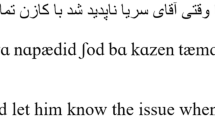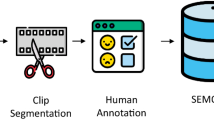Abstract
In this paper, we will examine the “speaker independent” performance of speech emotion recognition systems. The notion of independence suggests that irrespective of the personal attributes of the speaker–race, gender, age–and a reasonably clear speech, with little or no noise or distraction, then two different systems should give the same output. The difference in the systems lies in the use of training data for recognising emotions, algorithms for recognising human speech, and the spectral, prosodic, and quality attributes of the speech in the training data base. We describe the statistically significant differences between outputs of two major speech emotion recognition systems (SERS) - OpenSmile and Vokaturi. Both these systems were trained on posed training data. Our data sample comprised spontaneous speech data of politicians and their spokespersons – 71 people’s speech with an elapsed time of around 16.66 h. We have focused on speeches delivered by the politicians and the statements made by spokespersons; in some cases these may be answers to questions by journalists. There were differences due to the age and the race of our politicians and spokespersons. Even if we ignore the vagaries of spontaneous speech, the differences between the outputs of two major SERS indicates that (a) on the theoretical level, speaker independent claims of such systems do not match, and (b) on the practical level, efforts should be made to widen the training data to include a variety of races and ages and equally importantly to evaluate which of the spectral, prosodic and quality features should be used as the proxy for emotions.
Access this chapter
Tax calculation will be finalised at checkout
Purchases are for personal use only
Similar content being viewed by others
Notes
- 1.
In the current work, age is approximated: ongoing work related to this and a larger corpus that includes the works sampled here is enhanced by determining the age in years and months of the speaker in each recording at the time of the event recorded.
- 2.
We adopt distinctions as defined by the US Census Bureau [https://www.census.gov/topics/population/race/about.html - last verified 12/09/2022].
- 3.
Extremely low p-values are treated as zeros by the Python packages that are being used here.
References
Abramson, A.S., Whalen, D.H.: Theoretical and practical issues in measuring voicing distinctions: voice onset time (VOT) at 50. J. Phonetics 63, 75–86 (2017)
Ahmad, K., Wang, S., Vogel, C., Jain, P., O’Neill, O., Sufi, B.H.: Comparing the performance of facial emotion recognition systems on real-life videos: gender, ethnicity and age. In: Arai, K. (ed.) FTC 2021. LNNS, vol. 358, pp. 193–210. Springer, Cham (2022). https://doi.org/10.1007/978-3-030-89906-6_14
Akçay, M.B., Oğuz, K.: Speech emotion recognition: emotional models, databases, features, preprocessing methods, supporting modalities, and classifiers. Speech Commun. 116, 56–76 (2020)
Almaghrabi, S.A., et al.: The reproducibility of bio-acoustic features is associated with sample duration, speech task, and gender. IEEE Trans. Neural Syst. Rehabil. Eng. 30, 167–175 (2022)
Awan, S.N.: The aging female voice: acoustic and respiratory data. Clin. Linguist. Phonetics 20(2-3), 171–180 (2006)
Banse, R., Scherer, K.R.: Acoustic profiles in vocal emotion expression. J. Pers. Soc. Psychol. 70(3), 614–636 (1996)
Bao, W.: Building a Chinese natural emotional audio-visual database. In: 2014 12th International Conference on Signal Processing (ICSP), pp. 583–587. IEEE (2014)
Boersma, P.: PRAAT, a system for doing phonetics by computer. Glot Int. 5(9/10), 341–345 (2001)
Burkhardt, F., Paeschke, A., Rolfes, M., Sendlmeier, W.F., Weiss, B., et al.: A database of German emotional speech. Interspeech 5, 1517–1520 (2005)
Chen, H., Liu, Z., Kang, X., Nishide, S., Ren, F.: Investigating voice features for speech emotion recognition based on four kinds of machine learning methods. In: 2019 IEEE 6th International Conference on Cloud Computing and Intelligence Systems (CCIS), pp. 195–199. IEEE (2019)
Cho, T., Whalen, D.H., Docherty, G.: Voice onset time and beyond: exploring laryngeal contrast in 19 languages. J. Phonetics 72, 52–65 (2019)
Costantini, G., Parada-Cabaleiro, E., Casali, D., Cesarini, V.: The emotion probe: on the universality of cross-linguistic and cross-gender speech emotion recognition via machine learning. Sensors 22(7), 2461 (2022)
Cowen, A.S., Laukka, P., Elfenbein, H.A., Liu, R., Keltner, D.: The primacy of categories in the recognition of 12 emotions in speech prosody across two cultures. Nat. Hum. Behav. 3(4), 369–382 (2019)
Datta, D.: Ethnicity, gender, and language: comparing the performance of emotion recognition systems in different modalities (Non-verbal and Verbal) with emphasis on Bengali data (Unpublished). Master’s thesis, Trinity College Dublin, Dublin (2022)
Eichhorn, J.T., Kent, R.D., Austin, D., Vorperian, H.K.: Effects of aging on vocal fundamental frequency and vowel formants in men and women. J. Voice 32(5), 644–e1 (2018)
Hillary Anger Elfenbein and Nalini Ambady: On the universality and cultural specificity of emotion recognition: a meta-analysis. Psychol. Bull. 128(2), 203–235 (2002)
Elfenbein, H.A., Luckman, E.A.: Interpersonal accuracy in relation to culture and ethnicity. In: Judith, A.H., Mast, M.S., West, T.V. (eds.) The Social Psychology of Perceiving Others Accurately, pp. 328–349. Cambridge University Press (2016)
Eyben, F., Schuller, B.: openSMILE:) the Munich open-source large-scale multimedia feature extractor. ACM SIGMultimedia Rec. 6(4), 4–13 (2015)
Eyben, F., Wöllmer, M., Schuller, B.: OpenEAR-introducing the Munich open-source emotion and affect recognition toolkit. In: 2009 3rd International Conference on Affective Computing and Intelligent Interaction and Workshops, pp. 1–6. IEEE (2009)
Garcia-Garcia, J.M., Penichet, V.M.R., Lozano, M.D.: Emotion detection: a technology review. In: Proceedings of the XVIII International Conference on Human Computer Interaction, pp. 1–8 (2017)
Garofolo, J.S., Lamel, L.F., Fisher, W.M., Fiscus, J.G., Pallett, D.S.: DARPA TIMIT acoustic-phonetic continuous speech corpus CD-ROM. NIST speech disc 1-1.1. NASA STI/Recon technical report N, 93:27403 (1993)
Haq, S., Jackson, P.J.B.: Multimodal emotion recognition. In: Machine Audition: Principles, Algorithms and Systems, pp. 398–423. IGI Global (2011)
House, A.S., Fairbanks, G.: The influence of consonant environment upon the secondary acoustical characteristics of vowels. J. Acoust. Soc. Am. 25(1), 105–113 (1953)
Hussain, Q.: A typological study of voice onset time (VOT) in Indo-Iranian languages. J. Phon. 71, 284–305 (2018)
Hussain, Q., Mielke, J.: An acoustic and articulatory study of laryngeal and place contrasts of Kalasha (Indo-Aryan, Dardic). J. Acoust. Soc. Am. 147(4), 2873–2890 (2020)
Jauk, I.: Unsupervised learning for expressive speech synthesis. In: Proceedings IberSPEECH 2018, pp. 189–193 (2018)
Jauk, I., Bonafonte, A.: Prosodic and spectral iVectors for expressive speech synthesis. In: Proceedings 9th ISCA Workshop on Speech Synthesis Workshop (SSW 9), pp. 59–63 (2016)
Jiang, W.: Performance comparison of emotion recognition systems, and validation of physical correlates of emotions: across different ethnicities and languages with particular focus on Chinese(Unpublished). Master’s thesis, Trinity College Dublin, Dublin (2022)
Lanjewar, R.B., Mathurkar, S., Patel, N.: Implementation and comparison of speech emotion recognition system using gaussian mixture model (GMM) and K-Nearest Neighbor (k-NN) techniques. Procedia Comput. Sci. 49, 50–57 (2015)
Li, B., Dimitriadis, D., Stolcke, A.: Acoustic and lexical sentiment analysis for customer service calls. In: ICASSP 2019-2019 IEEE International Conference on Acoustics, Speech and Signal Processing (ICASSP), pp. 5876–5880. IEEE (2019)
Lisker, L., Abramson, A.S.: A cross-language study of voicing in initial stops: acoustical measurements. Word 20(3), 384–422 (1964)
Martin, O., Kotsia, I., Macq, B., Pitas, I.: The eNTERFACE 2005 audio-visual emotion database. In: 22nd International Conference on Data Engineering Workshops (ICDEW 2006), p. 8. IEEE (2006)
Özseven, T., Düğenci, M.: SPeech ACoustic (SPAC): a novel tool for speech feature extraction and classification. Appl. Acoust. 136, 1–8 (2018)
Pell, M.D., Paulmann, S., Dara, C., Alasseri, A., Kotz, S.A.: Factors in the recognition of vocally expressed emotions: a comparison of four languages. J. Phonetics 37(4), 417–435 (2009)
Pichora-Fuller, M.K., Dupuis, K., Van Lieshout, P.: Importance of F0 for predicting vocal emotion categorization. J. Acoust. Soc. Am. 140(4), 3401–3401 (2016)
Povey, D.: The Kaldi speech recognition toolkit. In: IEEE 2011 Workshop on Automatic Speech Recognition and Understanding. IEEE Sig. Process. Soc. (2011). https://infoscience.epfl.ch/record/192584. Last Verified Sept 2022
Rummer, R., Schweppe, J., Schlegelmilch, R., Grice, M.: Mood is linked to vowel type: the role of articulatory movements. Emotion 14(2), 246 (2014)
Saggio, G., Costantini, G.: Worldwide healthy adult voice baseline parameters: a comprehensive review. J. Voice (2020, in Press). Verified Sept. 2022. https://doi.org/10.1016/j.jvoice.2020.08.028.
Sataloff, R.T., Rosen, D.C., Hawkshaw, M., Spiegel, J.R.: The aging adult voice. J. Voice 11(2), 156–160 (1997)
Schröder, M., Cowie, R., Douglas-Cowie, E., Westerdijk, M., Gielen, S.: Acoustic correlates of emotion dimensions in view of speech synthesis. In: Seventh European Conference on Speech Communication and Technology, pp. 87–90 (2001)
Schuller, B., Steidl, S., Batliner, A.: The Interspeech 2009 emotion challenge. In: Proceedings of Interspeech 2009, pp. 312–315 (2009)
Schuller, B.W.: Speech emotion recognition: two decades in a nutshell, benchmarks, and ongoing trends. Commun. ACM 61(5), 90–99 (2018)
Sun, L., Zou, B., Sheng, F., Chen, J., Wang, F.: Speech emotion recognition based on DNN-decision tree SVM model. Speech Commun. 115, 29–37 (2019)
Vokaturi: The acoustic cues. https://developers.vokaturi.com/doc/doc/extract_cues.html. Accessed 14 Sept 2022
Vokaturi: Overview. https://developers.vokaturi.com/getting-started/overview. Accessed 08 Aug 2022
Wang, K., An, N., Li, B.N., Zhang, Y., Li, L.: Speech emotion recognition using Fourier parameters. IEEE Trans. Affect. Comput. 6(1), 69–75 (2015)
Acknowledgments and Contributions
Khurhsid Ahmad is the Principal Investigator on this project, Carl Vogel is a co-principal and has designed the statistical tests for the reported comparisons, Deepayan Datta and Wanying Jiang are post-graduate students working on our project. We would like to thank Subishi Chemmarathil for her help in curating the database.
Author information
Authors and Affiliations
Corresponding author
Editor information
Editors and Affiliations
Rights and permissions
Copyright information
© 2023 The Author(s), under exclusive license to Springer Nature Switzerland AG
About this paper
Cite this paper
Datta, D., Jiang, W., Vogel, C., Ahmad, K. (2023). Speech Emotion Recognition Systems: A Cross-Language, Inter-racial, and Cross-Gender Comparison. In: Arai, K. (eds) Advances in Information and Communication. FICC 2023. Lecture Notes in Networks and Systems, vol 651. Springer, Cham. https://doi.org/10.1007/978-3-031-28076-4_28
Download citation
DOI: https://doi.org/10.1007/978-3-031-28076-4_28
Published:
Publisher Name: Springer, Cham
Print ISBN: 978-3-031-28075-7
Online ISBN: 978-3-031-28076-4
eBook Packages: Intelligent Technologies and RoboticsIntelligent Technologies and Robotics (R0)




